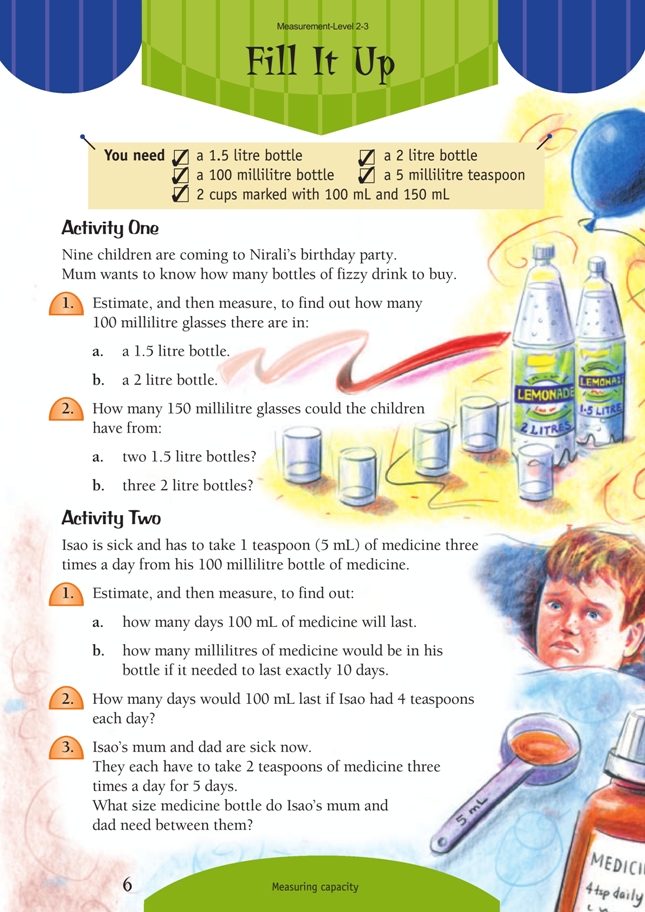This is a level 3 measurement strand activity from the Figure It Out series.
A PDF of the student activity is included.
Click on the image to enlarge it. Click again to close. Download PDF (193 KB)
solve problems involving capacity
measure capacity in millilitres
5 mL teaspoon
FIO, Level 2-3, Measurement, Fill it Up, page 6
2 cups marked with 100mL and 150mL
Activity One
This activity focuses on capacity.
The most common capacity of glasses is either 200 or 250 millilitres. Small glasses, such as those that hold sandwich spreads, often contain 100 millilitres. Many students will solve these types of problems by pouring liquid into the bottle glass by glass and will make no reference to the units at all. The mechanical drudgery of such methods will leave students receptive to more efficient methods that use metric units.
Understanding the connection between millilitres and litres involves some comprehension of place value because the metric system is based on ten. Encourage students to discover the relationship from their findings, with questions such as:
“You think the 2 litre bottle holds 10 glasses. How many glasses would a 1 litre bottle hold?”
“Does your answer match with the number of glasses in the 1.5 litre bottle?”
“Use a measuring jug to find out how much water one glass holds. How much water will a 1 litre bottle hold, then?” (The capacity of the glass will be read in millilitres.)
“How many millilitres are there in 1 litre? I wonder what ‘milli’ means?” (1000)
Once students have developed a feel for the capacity of glasses and bottles, this understanding can be applied by getting containers such as a 3 litre fruit juice bottle and asking how many glasses of juice it holds. Estimates can be revised as successive glasses of water are poured in.
Activity Two
Using medicine bottles is an excellent way of helping students to relate to capacity. Medicine bottles commonly come in 100 millilitre or 200 millilitre capacities and are available cheaply from chemist shops. Students often solve Isao’s problem by pouring out spoonfuls one at a time. Medicine bottles have their capacity written on the bottom, and this can be used as a hint to encourage more efficient strategies. Appropriate recording is important in solving these problems.
Encourage efforts such as:
5 + 5 + 5 + 5 + … + 5 + 5 = 100 (20 teaspoons)
or 5 + 5 + 5 = 15
15 + 15 + 15 + … + 15 = 105 Not enough for 7 days!
Such recording often reveals the use of repeated addition, which can be used to develop more efficient multiplication and division strategies. You could ask, “Is there an easier way to work out 5 + 5 + 5 + 5 …?”
Answers to Activity
Activity One
1. a. 15 glasses
b. 20 glasses
2. a. 20 glasses
b. 40 glasses
Activity Two
1. a. The bottle holds 20 teaspoons of medicine, so it will last 7 days. There is enough for 6 days and 2 teaspoons on the seventh day.
b. For 10 days, he needs 15 mL a day x 10. So he needs 150 mL.
2. As the bottle holds 20 teaspoons, it will last exactly 5 days if he takes 4 teaspoons a day.
3. His mum and dad must take 30 teaspoons of medicine each, and 60 teaspoons is 300 mL. They need a 300 mL bottle.
